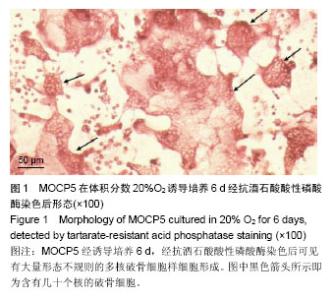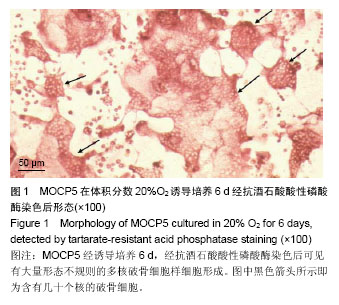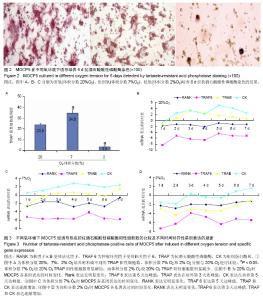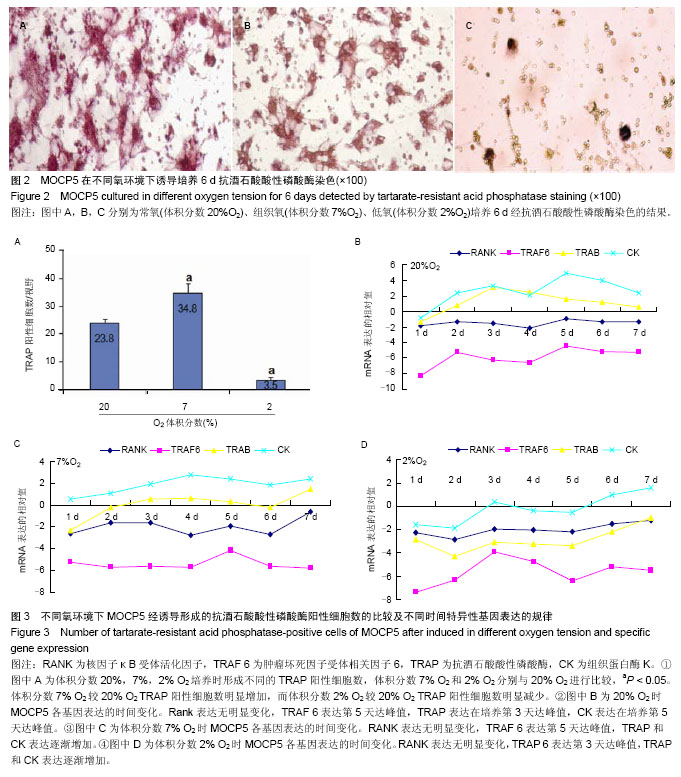| [1] Muzylak M, Price JS, Horton MA. Hypoxia Induces Giant Osteoclast Formation and Extensive Bone Resorption in the Cat. Calcif Tissue Int. 2006;79:301-309.
[2] Arnett TR, Gibbons DC, Utting JC, et al. Hypoxia is a major stimulator of osteoclast formation and bone resorption. J Cell Physiol. 2003;196(1):2-8.
[3] Hiraga T, Kizaka-Kondoh S, Hirota K, et al. Hypoxia and hypoxia-inducible factor-1 expression enhance osteolytic bone metastases of breast cancer. Cancer Res. 2007;67(9): 4157-4163.
[4] Knowles HJ, Athanasou NA. Acute hypoxia and osteoclast activity: a balance between enhanced resorption and increased apoptosis. J Pathol. 2009;218(2):256-264.
[5] 郎红梅,金小岚,万勇,等.低氧对小鼠破骨细胞分化影响的时间依赖关系[J].中国组织工程与临床康复,2010,14(28):5136-5140.
[6] Nomura T, Aoyama M, Waguri-Nagaya Y, et al. Tumor ne crosis factor stimulates osteoclastogenesis from human bone marrow cells under hypoxic conditions. Exp Cell Res. 2014; 321(2):167-177.
[7] 梁静,邓廉夫,朱雅萍,等.不同氧环境中破骨细胞的发育分化和功能变化研究[J].中国骨质疏松杂志,2008,14(5):313-317.
[8] 朱伟平,史伟,林琳,等.核因子κB受体活化因子配体诱导破骨细胞前体的培养与分化[J].中国组织工程研究,2013,17(46): 7981-7987.
[9] 包洪卫,孙继芾,王青.巨噬细胞集落刺激因子/核因子κB受体激活物配体体外诱导培养高纯度破骨细胞:最佳剂量探讨[J].中国组织工程研究,2010,14(2)191-195.
[10] Lewis JS, Lee JA, Underwood JC, et al. Macrophage responses to hypoxia: relevance to disease mechanisms. J Leukoc Biol. 1999;66(6):889-900.
[11] Kallinowski F, Schlenger KH, Runkel S, et al. Blood flow, metabolism, cellular microenvironment, and growth rate of human tumor xenografts. Cancer Res. 1989;49(14): 3759-3764.
[12] Harrison JS, Rameshwar P, Chang V, et al. Oxygen saturation in the bone marrow of healthy volunteers. Blood. 2002;99(1): 394.
[13] Utting JC, Robins SP, Brandao-Burch A, et al. Hypoxia inhibits the growth, differentiation and bone-forming capacity of rat osteoblasts. Exp Cell Res. 2006;312(10):1693-1702.
[14] Gaber T, Dziurla R, Tripmacher R, et al. Hypoxia inducible factor (HIF) in rheumatology: low O2! See what HIF can do! Ann. Rheum. Dis. 2005;64(7):971-980.
[15] Watanabe Y, Terashima Y, Takenaka N, et al. Prediction of avascular necrosis of the femoral head by measuring intramedullary oxygen tension after femoral neck fracture, J Orthop Trauma. 2007;21(7)456-461.
[16] Dunst J, Ahrens S, Paulussen M, et al. Prognostic impact of tumor perfusion in MR-imaging studies in Ewing tumors. Strahlenther Onkol. 2001;177(3)153-159.
[17] Motohira H, Hayashi J, Tatsumi J, et al. Hypoxia and reoxygenation augment bone-resorbing factor production from human periodontal ligament cells. J Periodontol. 2007; 78(9):1803-1809.
[18] Park HJ, Baek KH, Lee HL, et al. Hypoxia inducible factor-1α directly induces the expression of receptor activator of nuclear factor-κB ligand in periodontal ligament fibroblasts. Mol Cells. 2011;31(6):573-578.
[19] Morten KJ1, Badder L, Knowles HJ. Differential regulation of HIF-mediated pathways increases mitochondrial metabolism and ATP production in hypoxic osteoclasts. J Pathol 2013; 229(5):755-764.
[20] Yamasaki N, Tsuboi H, Hirao M, et al. High oxygen tension prolongs the survival of osteoclast precursors via macrophage colony-stimulating factor. Bone. 2009;44(1): 71-79.
[21] Franco GC, Kajiya M, Nakanishi T, et al. Inhibition of matrix metalloproteinase-9 activity by doxycycline ameliorates RANK ligand-induced osteoclast differentiation in vitro and in vivo. Exp Cell Res. 2011;317(10):1454-1464.
[22] Hyeon S, Lee H, Yang Y, et al. Nrf2 deficiency induces oxidative stress and promotes RANKL-induced osteoclast differentiation. Free Radic Biol Med. 2013;65:789-799.
[23] Boyce BF, Xing L. Functions of RANKL/RANK/OPG in bone modeling and remodeling. Arch Biochem Biophys. 2008; 473(2):139-146.
[24] Kim AR, Kim HS, Lee JM, et al. Arctigenin suppresses receptor activator of nuclear factor κB ligand (RANKL)-mediated osteoclast differentiation in bone marrow-derived macrophages. Eur J Pharmacol. 2012; 682(1-3):29-36..
[25] Wada T, Nakashima T, Hiroshi N, et al. RANKL-RANK signaling in osteoclastogenesis and bone disease. Trends Mol Med. 2006;12(1):17-25.
[26] Choi J, Choi SY, Lee SY, et al. Caffeine enhances osteoclast differentiation and maturation through p38 MAP kinase/Mitf and DC-STAMP/CtsK and TRAP pathway. Cell Signal. 2013; 25(5):1222-1227.
[27] Igarashi Y, Lee MY, Matsuzaki S. Acid phosphatases as markers of bone metabolism. J Chromatogr B. 2002;781(1-2): 345-358.
[28] Zhao Q, Jia Y, Xiao Y. Cathepsin K: a therapeutic target for bone diseases. Biochem Biophys Res Common. 2009;380(4): 721-723.
[29] Novinec M, Lenar?i? B. Cathepsin K: a unique collagenolytic cysteine peptidase. Biol Chem. 2013;394(9):1163-1179.
[30] Troeberg L, Nagase H. Proteases involved in cartilage matrix degradation in osteoarthritis. Biochim Biophys Acta. 2012; 1824(1):133-145. |



